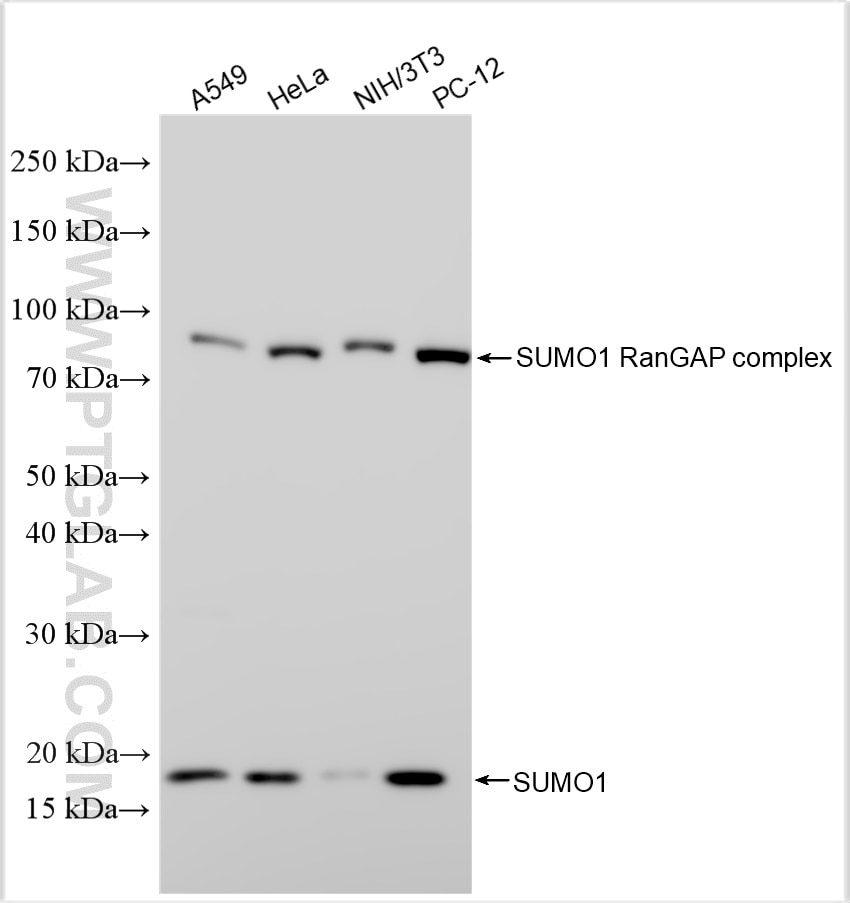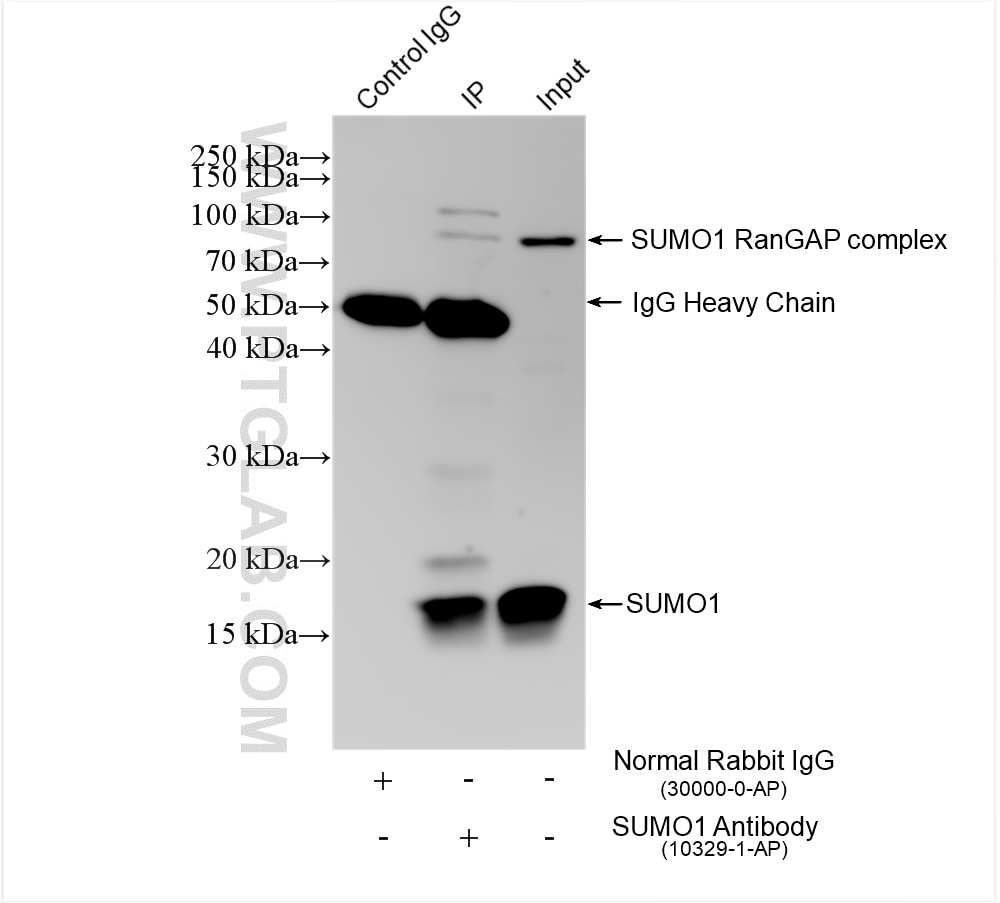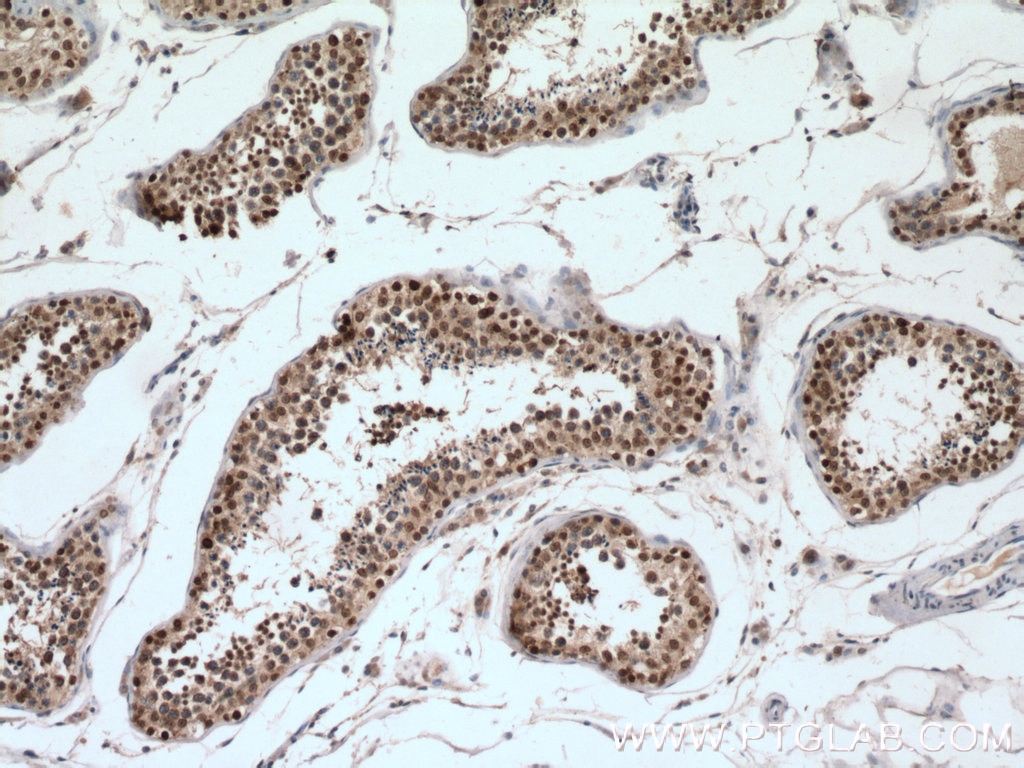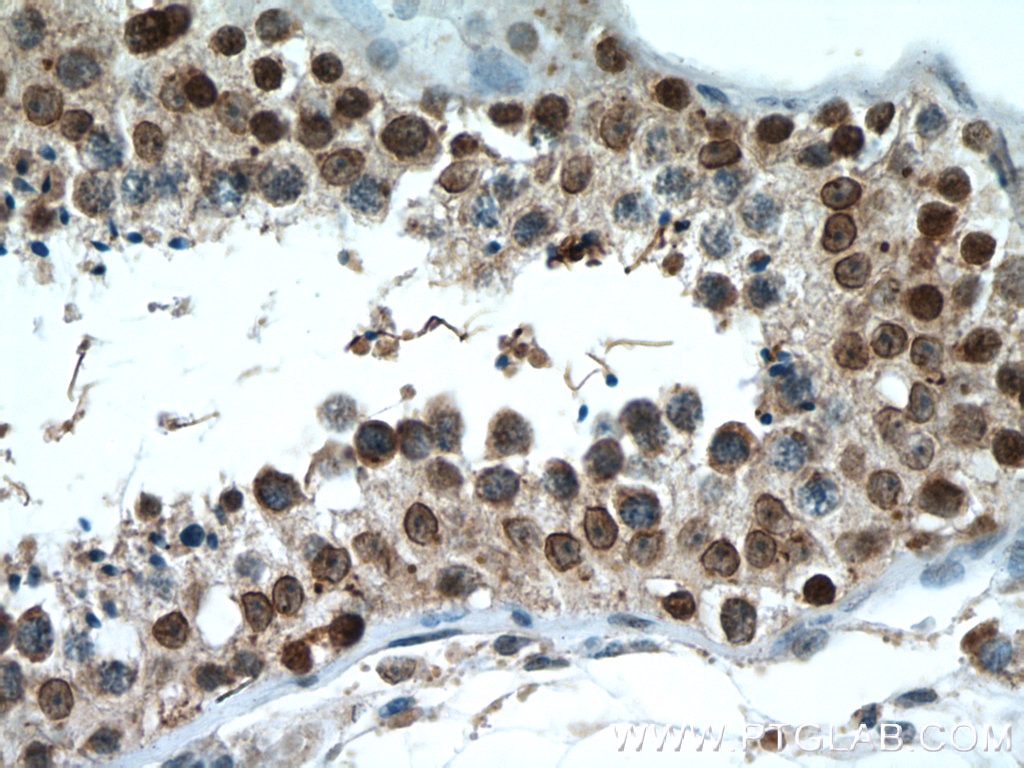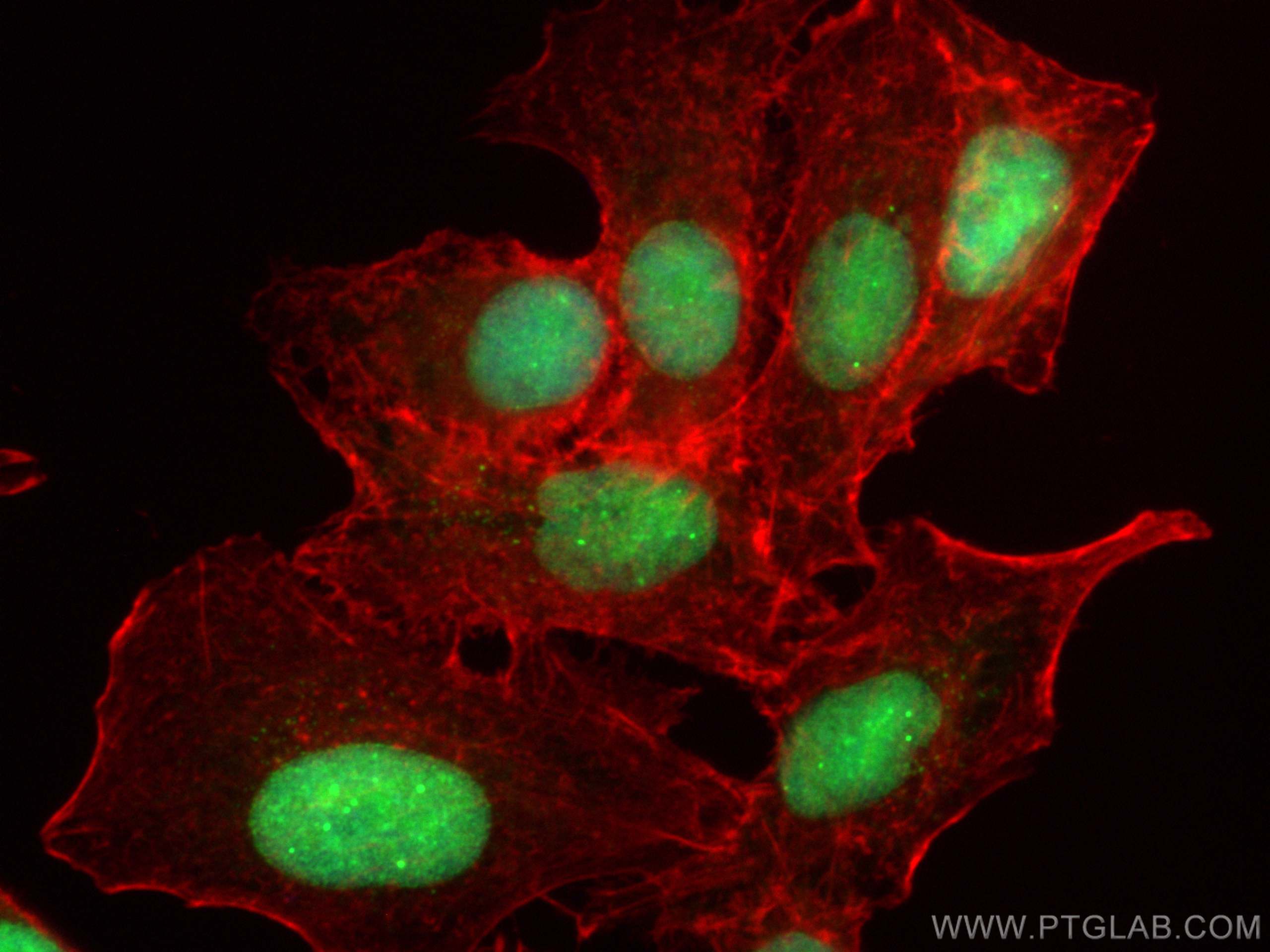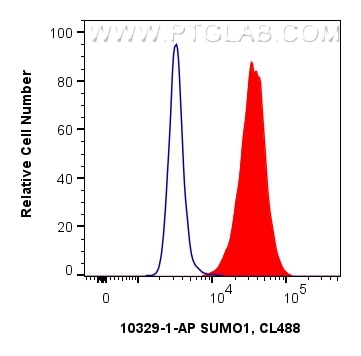Anticorps Polyclonal de lapin anti-SUMO1
SUMO1 Polyclonal Antibody for WB, IHC, IF/ICC, FC (Intra), IP, ELISA
Hôte / Isotype
Lapin / IgG
Réactivité testée
Humain, rat, souris
Applications
WB, IHC, IF/ICC, FC (Intra), IP, CoIP, ELISA
Conjugaison
Non conjugué
N° de cat : 10329-1-AP
Synonymes
Galerie de données de validation
Applications testées
| Résultats positifs en WB | cellules A549, cellules HeLa, cellules NIH/3T3, cellules PC-12 |
| Résultats positifs en IP | cellules HeLa, |
| Résultats positifs en IHC | tissu testiculaire humain, il est suggéré de démasquer l'antigène avec un tampon de TE buffer pH 9.0; (*) À défaut, 'le démasquage de l'antigène peut être 'effectué avec un tampon citrate pH 6,0. |
| Résultats positifs en IF/ICC | cellules A549, |
| Résultats positifs en FC (Intra) | cellules A549, |
Dilution recommandée
| Application | Dilution |
|---|---|
| Western Blot (WB) | WB : 1:1000-1:4000 |
| Immunoprécipitation (IP) | IP : 0.5-4.0 ug for 1.0-3.0 mg of total protein lysate |
| Immunohistochimie (IHC) | IHC : 1:50-1:500 |
| Immunofluorescence (IF)/ICC | IF/ICC : 1:200-1:800 |
| Flow Cytometry (FC) (INTRA) | FC (INTRA) : 0.40 ug per 10^6 cells in a 100 µl suspension |
| It is recommended that this reagent should be titrated in each testing system to obtain optimal results. | |
| Sample-dependent, check data in validation data gallery | |
Applications publiées
| WB | See 28 publications below |
| IF | See 3 publications below |
| IP | See 8 publications below |
| CoIP | See 1 publications below |
Informations sur le produit
10329-1-AP cible SUMO1 dans les applications de WB, IHC, IF/ICC, FC (Intra), IP, CoIP, ELISA et montre une réactivité avec des échantillons Humain, rat, souris
| Réactivité | Humain, rat, souris |
| Réactivité citée | rat, Humain, souris |
| Hôte / Isotype | Lapin / IgG |
| Clonalité | Polyclonal |
| Type | Anticorps |
| Immunogène | SUMO1 Protéine recombinante Ag0414 |
| Nom complet | SMT3 suppressor of mif two 3 homolog 1 (S. cerevisiae) |
| Masse moléculaire calculée | 12 kDa |
| Poids moléculaire observé | 12~18 kDa, 80-90 kDa |
| Numéro d’acquisition GenBank | BC006462 |
| Symbole du gène | SUMO1 |
| Identification du gène (NCBI) | 7341 |
| Conjugaison | Non conjugué |
| Forme | Liquide |
| Méthode de purification | Purification par affinité contre l'antigène |
| Tampon de stockage | PBS with 0.02% sodium azide and 50% glycerol |
| Conditions de stockage | Stocker à -20°C. Stable pendant un an après l'expédition. L'aliquotage n'est pas nécessaire pour le stockage à -20oC Les 20ul contiennent 0,1% de BSA. |
Informations générales
Small ubiquitin-related modifier 1 (SUMO1) belongs to the ubiquitin family and the SUMO subfamily as it contains 1 ubiquitin-like domain and is also 18% identical to ubiquitin (PMID: 9654451).
1. What is the molecular weight of SUMO1?
The molecular weight of SUMO1 is 12 kDa.
2. What is the cellular localization of SUMO1?
SUMO1 is located in the nuclear membrane and is recruited by BCL11A to the nuclear body (PMID: 18681895).
3. What modifications is SUMO1 subjected to?
SUMO1 function occurs after the cleavage of its precursor form by SENP1 or SENP2 (PMID: 27576863). Polymeric SUMO1 chains also undergo polyubiquitination by RNF4 (PMID: 18408734).
4. What is the function of SUMO1?
SUMO1 post-translationally modifies many proteins that have roles in an array of processes including transcriptional regulation, chromatin structure, and DNA repair. SUMO1 can covalently attach itself to protein as a monomer or a lysine-linked polymer via an isopeptide bond (PMID:11124955). This SUMO modification can regulate the localization and activity of the affected proteins.
5. What is SUMO1's involvement in disease?
Defects in SUMO1 as a result of a chromosomal translocation are associated with non-syndromic orofacial cleft type 10, or non-syndromic cleft lip, and are associated with cleft palate in two-thirds of cases (PMID: 18983974).
Protocole
| Product Specific Protocols | |
|---|---|
| WB protocol for SUMO1 antibody 10329-1-AP | Download protocol |
| IHC protocol for SUMO1 antibody 10329-1-AP | Download protocol |
| IF protocol for SUMO1 antibody 10329-1-AP | Download protocol |
| IP protocol for SUMO1 antibody 10329-1-AP | Download protocol |
| Standard Protocols | |
|---|---|
| Click here to view our Standard Protocols |
Publications
| Species | Application | Title |
|---|---|---|
Sci Adv XAF1 promotes anti-RNA virus immune responses by regulating chromatin accessibility | ||
Cell Death Differ ZNF451 collaborates with RNF8 to regulate RNF168 localization and amplify ubiquitination signaling to promote DNA damage repair and regulate radiosensitivity | ||
Cell Death Dis Ubc9 regulates the expression of MHC II in dendritic cells to enhance DSS-induced colitis by mediating RBPJ SUMOylation | ||
Int J Biol Macromol SUMOylation of GMFB regulates its stability and function in retinal pigment epithelial cells under hyperglycemia | ||
Theranostics Chlorogenic acid effectively treats cancers through induction of cancer cell differentiation. | ||
Free Radic Biol Med Sentrin-specific protease 1 maintains mitochondrial homeostasis through targeting the deSUMOylation of sirtuin-3 to alleviate oxidative damage induced by hepatic ischemia/reperfusion |
Avis
The reviews below have been submitted by verified Proteintech customers who received an incentive for providing their feedback.
FH Zoe (Verified Customer) (10-08-2021) | Hadn’t previously had much luck with antibodies on my Tricky construct so was great to use this one!
|
